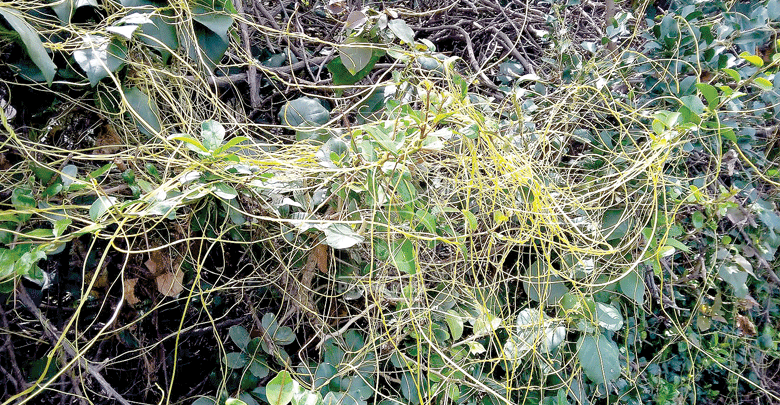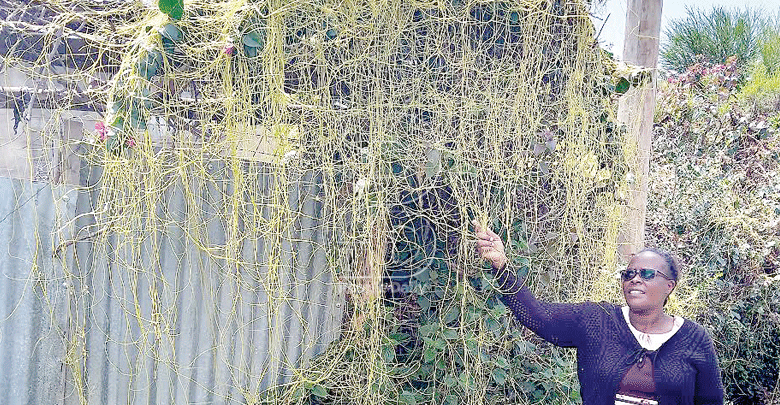Parasitic plant attack wreaks havoc for Kitengela residents
By Mwangi Mumero, June 1, 2021Tending to her well-manicured flower bed, Susan Gachaiya, a resident of New Valley Estate in Kitengela, Kajiado county is worried about the creeping plant attacking her garden and hedges.
Yellow in colour and thread-like, the invasive, parasitic plant known as the dodder plant has ruined beautiful flower beds and hedges, not only in her home, but the entire area by enmeshing them into its destructive threads-threatening biodiversity.
“Unless a quick solution is found, this plant will destroy all the effort of beautifying our lawns and sheds in people’s homes. It is spreading quickly across the estates in Kitengela,” said Susan.
Another neighbour Johnstone Musau has equally been mesmerised by the rapid colonisation of his flower beds by the plant.
“It has forced me to prune the whole flower bed as I try to kill the invasive plant much to no avail, since as my flowers were developing shoots, the plant re-emerged,” noted Musau
It is not just residents of Kitengela and the larger Nairobi region who are being affected, visitors to Murangá, Nyeri and even Western Kenya have noted the increasing spread of the invasive plant, which has enmeshed live fences, trees and flower species killing some of them in its wake.
Researchers say, dodder, scientifically known as Cuscuta species is a parasitic invasive weed currently threatening biodiversity in Kenya.
It is alien to Africa and is thought to be originally from North America and the Caribbean regions.

Dodder seeds are dispersed by wind, water, birds, other animals, and by man on machines and planting material contaminated by dodder seeds.
Other pathway for the spread of the dodder is the trade on plants grown as ornamentals, recreational parks and cities, contaminated harvest or flooding where mature seeds are eroded and swept downstream.
Research conducted by Innocent Ngare, a PhD fellow, Environment For Sustainable Urban Development and his colleagues in the Department of Environmental Science and Education, School of Environmental Studies at Kenyatta University shows attacks by the plant on ornamental trees, shrubs and herbaceous plants were either affected moderately or extremely.
According to Ngare, it will be nearly impossible to control the dodder weed in the next decade if national governments fail to take quick action.
Currently, the weed is found in a wide variety of hosts, including crops in the farms, bushy and waste places as well as forests-virtually decimating them.
Three dodder species, Cuscuta reflexa, a South Asia dodder, Cuscuta campestris and Cuscuta kilimanjari, have been identified in Kenya.
Among the flowers species severely affected by dodder infestation is the yellow oleander trees and bougainvillea plant species.
Mango trees are also getting affected, especially in drier parts the country, such as Machakos and Makueni.
According to Centre for Agriculture and Bioscience International (CABI) scientists, dodder builds a canopy on the host plant and casts thousands of tendrils to form a dense spectacle before it strangles and eventually killing it.
In grasslands and rangelands, dodder and other invasive plants are also threatening biodiversity and wildlife. “Alien plant invasions pose significant threats to conservation and livelihoods.
As such, it would be prudent to develop and implement management strategies to reduce the threats of all invasive and potentially invasive plant species,” observed Dr Arne Witt, a researcher at CABI.
The researchers strongly advocate the use of biological controls as cost effective, safe and environmentally sustainable ways to manage some of the invasive plants as part of an integrated management plan.
Dr Witt added that there are many benefits to the use of biological controls, including the fact that many agents establish self-perpetuating populations, often across the whole range of the target species, and most projects only require a one-off investment.
Some of the biological methods used in controlling invasive plant species is the use of beetles and other natural enemies, such as wasps, which naturally tame the plant species.
Researchers also recommend hand removal of the dodder threads on ornamentals and flowers. Pruning is also recommended although it might not be effective in heavy infestations.
In areas of large infestations, a pre-emergence herbicide may be used followed up by close mowing, burning or spot removal of the afflicted host plants.
Beyond the threat on hedges, lawns and flower beds in urban centres, dodder has been reported to attack crops and fruits.
In Western Kenya, it is affecting tomatoes, sweet potatoes, tea, coffee and potatoes, threatening food security.
